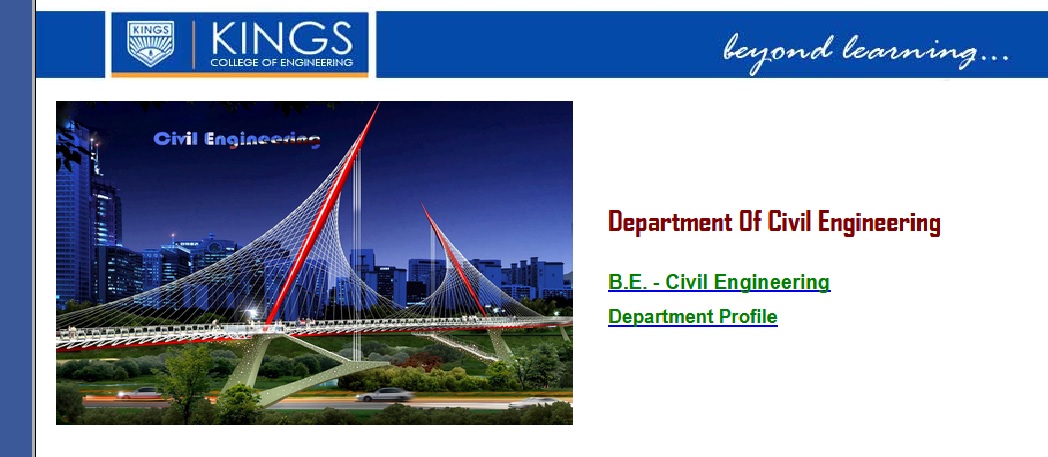CE1351 Design of Reinforced Concrete & Masonry Structures B.E Question Bank : kings.ac.in
Name of the College : Kings College of Engineering
University : Anna University Chennai
Department : Civil Engineering
Subject Code/Name : CE1351-Design of Reinforced Concrete & Masonry Structures
Year : III
Semester : VI
Degree : B.E
Website : kings.ac.in
Document Type : Question Bank
Download : https://www.pdfquestion.in/uploads/ki…STRUCTURES.pdf
Kings Design of Reinforced Concrete Question Paper
Unit – I
Retaining Walls :
Part-A :
1. What is a Retaining wall? :
Retaining walls are generally used to retain earth or such materials to maintain unequal levels on its two faces. The soil on the back face is at a higher level and is called back fill. Retaining wall are extensively used in the construction of basements below ground level, wing walls of bridge and to retain slopes in hilly terrain roads.
Related : Kings College of Engineering CE1352 Structural Analysis B.E Question Bank : www.pdfquestion.in/1536.html
2. What are the disadvantages of gravity retaining walls? :
Gravity walls of stone masonry were generally used in the earlier days to the height of the earth fill. The advent of reinforced concrete has resulted in thinner retaining walls.
3. What are the types of retaining walls? :
Retaining wall can be classified structurally as
1.Cantilever retaining wall
2.Counter fort retaining wall
4. What is a cantilever retaining wall? :
The most common and widely used retaining wall is of cantilever type. Vertical stem resisting earth pressure one side and the slab bends like a cantilever. The thickness of the vertical slab is large at the bottom and decreases towards the top in proportion to the varying soil pressure.
5. What is a counter fort retaining wall? :
Counter fort retaining walls are used for large heights exceeding 5 mts of earth fill. In counterfort retaining wall the vertical stem is designed as a continuous slab spanning between the counterforts. Counter forts are designed as cantilever beams from the base slab.

6. What are the forces acting on a retaining wall? :
Forces acting on a retaining wall are
1.Lateral earth pressure due to the back fill
2.Vertical forces including weight of soil, stem, heel, toe, and soil fill above the toe.
3.The soil pressure developed to resist the earth pressure and other vertical forces acting on the heel and toe.
7. Define Active Earth pressure.
If the soil exerts a push against the wall by virtue of its tendency to slip laterally and seek its natural slope (angle of repose) thus making the wall to move slightly away from the back filled soil mass. This kind of pressure is known as AEP.
8. Define Passive earth pressure.
The pressure or resistance which soil develops in response to movement of the structure towards it is called the Passive Earth Pressure.
9 What are the stability conditions should be checked for the retaining walls?:
The stability of retaining walls should be checked against the following conditions The wall should be stable against sliding
(a) The wall should be stable against Overturning
(b) The wall should be stable against Bearing capacity failure.
10 What is meant by backfill? :
The material retained or supported by a retaining wall is called backfill.
11 What is meant by surcharge? :
The position of the backfill lying above the horizontal plane at the elevation of the top of a wall is called the surcharge.
12 What is a gravity retaining wall? :
A gravity retaining wall is the one in which the earth pressure exerted by the backfill is resisted by dead weight of the wall, which is either made of masonry or mass concrete.
13 What is meant by submerged backfill? :
The sand fill behind the retaining wall saturated with water is called submerged backfill.
14 What is the function of counterforts in a retaining wall? :
The stem of the counterfort retaining wall acts as a continuous slab supported on counterforts.The counterforts take reactions both from the stem as well as the heel slab. Since the active earthpressure on stem acts outwards, and net pressure heel slab acts downwards, the counterforts aresubjected to tensile stresses along the outerface of the counterforts.
15 What is meant by back anchoring of retaining wall? :.
When the height of retaining wall is much more, it becomes uneconomical to provide counterforts. In order to reduce the section of stem etc. in the high retaining walls, the stem may be anchored at its back. The anchor practically takes all the earth pressure and B.M and S.F. in the stem are greatly reduced.